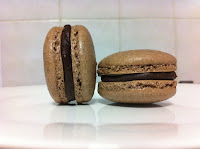
144g egg whites (temp and age not important!)
72g sugar
the scrapings of 1 vanilla bean or 2 tsp vanilla extract
2g salt
Sift the powdered sugar and almond meal twice, set aside.
In the bowl of a stand mixer, combine the egg whites, sugar, vanilla bean (not the extract), and salt and turn the mixer to medium (4 on a Kitchen Aid).
Whip for 3 minutes. They will not seem especially foamy at that point.
Increase the speed to medium-high (7 on a Kitchen Aid) and whip another 3 minutes
Then crank the speed to 8 for go another 4 minutes.
You should have a very stiff, dry meringue.
When you remove the whisk attachment, there will be a big clump of meringue in the center, just knock the whisk against the bowl to free it.If the meringue has not become stiff enough to clump inside the whisk, continue beating for another minute, or until it does so.
Now dump in the dry ingredients all at once and fold them in with a rubber spatula. Use both a folding motion (to incorporate the dry ingredients) and a pressing motion, to deflate the meringue against the side of the bowl.
The dry ingredients/meringue will look hopelessly incompatible.
After about 25 turns (or folds or however you want to call “a single stroke of mixing”) the mixture will still have a quite lumpy and stiff texture. Another 15 strokes will see you to “just about right.” Keep in mind that macaronage is about deflating the whites, so don’t feel like you have to treat them oh-so-carefully. You want to knock the air out of them.
Undermixed macaron batter: quite stiff. If you spoon some out and drop it back into the mix, it will just sit there and never incorporate. Do this test before bagging your batter and save yourself the trouble of baking of undermixed macarons!
Overmixed macaron batter: has a runny, pancake batter-like texture. It will ooze continuously, making it impossible to pipe into pretty circles. Um, try not to reach that point.
You can evaluate your batter one stroke at a time, no rush.
Essentially, the macaron batter needs enough thickness that it will mound up on itself, but enough fluidity that after 20 seconds, it will melt back down. I’ve heard people describe this consistency as lava-like, or molten
Transfer about half the batter to a piping bag. (When your bag is too full, the pressure causes the batter to rush out in a way that’s difficult to control, making for sloppy macarons.)
Pipe the batter into the pre-traced circles on the baking sheet. Stop piping just shy of the borders of the circle, as the batter will continue to spread just a bit.

After piping your macarons, take hold of the sheet pan and it hard against your counter. Rotate the pan ninety
degrees and rap two more times. This will dislodge any large air bubbles that might cause your macarons to crack
Set aside for up to 1/2 hour or so
Bake for about 18 minutes, or until you can cleanly peel the parchment paper away from a macaron. If, when you try to pick up a macaron, the top comes off in your hand, it’s not done.

Once the macarons have baked, cool thoroughly on the pans, before peeling the cooled macarons from the parchment. Use a metal spatula if necessary.
Fill a pastry bag fitted with the filling of your choice and pipe a quarter sized mound of filling into half of the shells, then sandwich them with their naked halves.
Macarons, against all pastry traditions, actually get better with age. The shells soften and become more chewy, mingling with the flavor of the filling too. So, while of course you can eat them right away, don’t hesitate to store them refrigerated for up to a week. If at all possible, set them out at room temperature for a few hours before consuming.



No comments:
Post a Comment